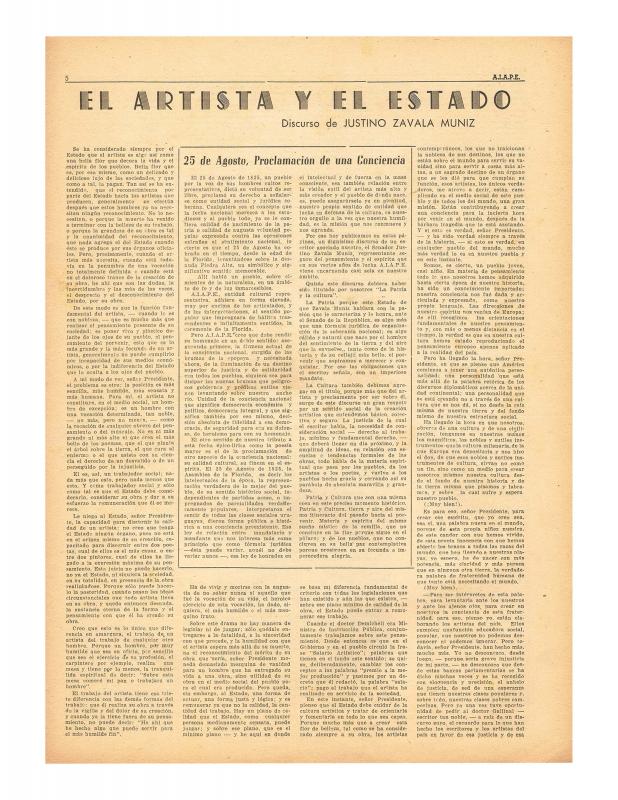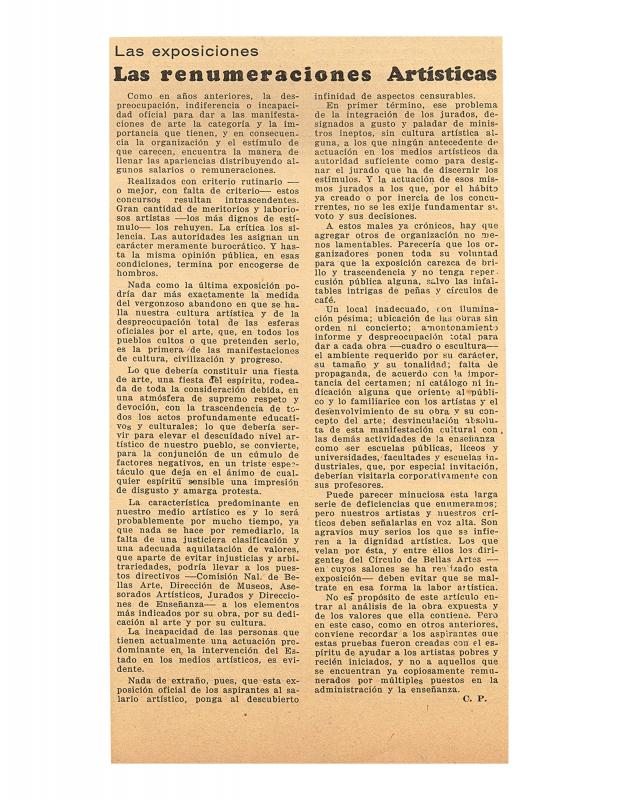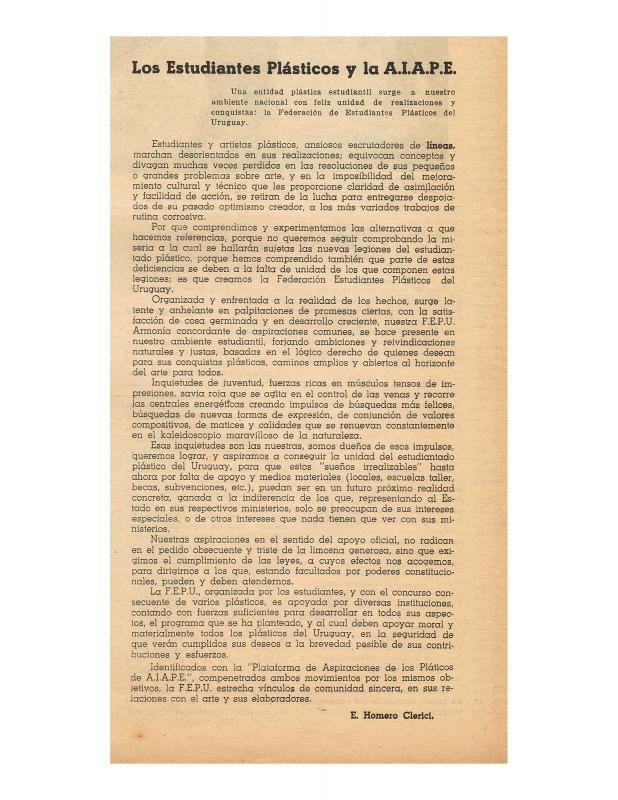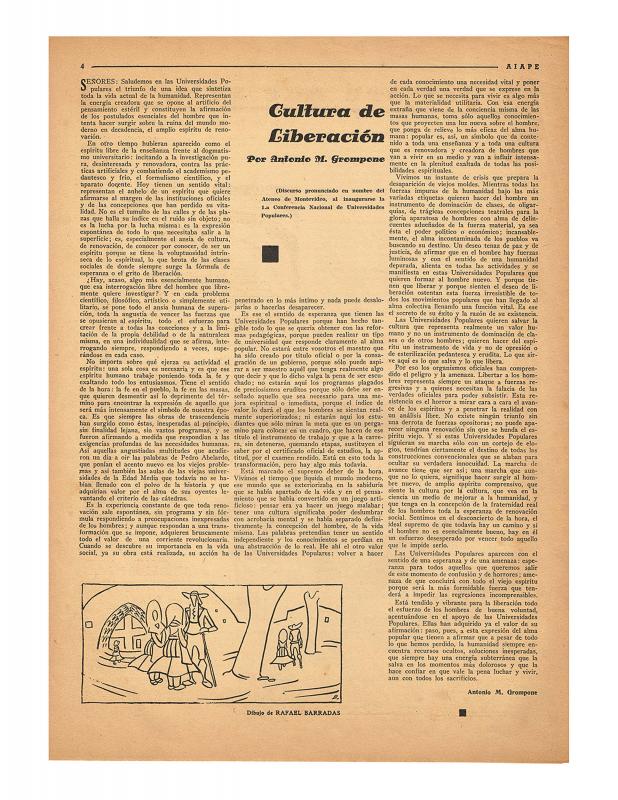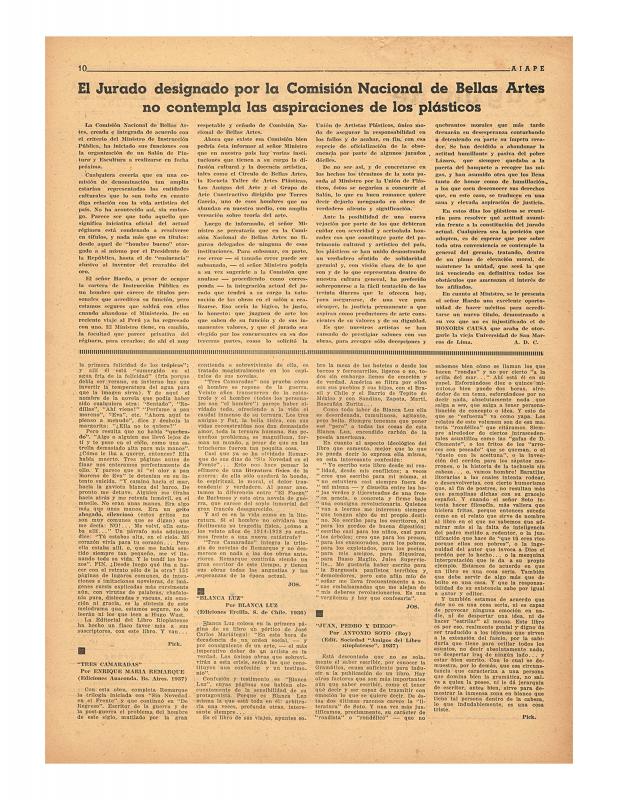Faced with the spread of fascism, many intellectuals in the Río de la Plata region, especially those who were members of the PCU (Partido Comunista Uruguayo), adhered to the guidelines laid down by the Komintern (via “popular fronts”) and, as had been done in Buenos Aires the previous year, founded the AIAPE (Agrupación de Intelectuales, Artists, Periodistas y Escritores) in Montevideo. This group and its homonymous journal AIAPE replaced the CTIU (Confederación de Trabajadores Intelectuales de Uruguay) and its publication Movimiento. The AIAPE groups that were founded in various Latin American countries created a regional network of intellectuals and artists—which was originally formed in Argentina in 1935 at the urging of Aníbal Ponce (1898–1938)—whose goal was to combat the cultural decline caused by conservative and pro-fascist policies. The AIAPE groups operated in several Latin American countries, in different circumstances but driven by similar goals, with the support of regional Communist Parties, all of which were aligned with the USSR. The AIAPE journal’s efforts to bring together large groups of intellectuals to oppose the authoritarian measures in Uruguay—the 1933 coup d’état that brought the country under the thumb of the Gabriel Terra dictatorship and its fascist ideals—reflected the importance of the magazine. It underscored the association’s unconditional support of Republican Spain, thus expressing the solidarity of Uruguayan intellectuals who opposed the rise of classist and racist authoritarianism in Europe and the Americas. The drumbeat of Uruguayan visual artists’ demands was growing ever louder in 1935, challenging the paradigm of the “Welfare State” that had been introduced in the 1920s. The profusion of local groups and the alignment of different segments of society in response to the cultural policies imposed by the government (the Gabriel Terra dictatorship that took power in 1933) and the international situation (the Spanish Civil War and the Second World War) fostered a mood of heated ideological debate that affected all intellectual segments as can be seen in the platform endorsed by visual artists who were members of the AIAPE (Agrupación de Intelectuales, Artistas, Periodistas y Escritores, which was founded 1936). It is interesting to note that this platform included demands for grants and scholarships that considered alternative destinations (such as Mexico or the United States), as a result of greater interaction with other Latin American countries, and changes in the country’s international policies; the platform claimed that the 1907 Scholarship Law was obsolete and fell short of requirements. The guarantees these groups were demanding underscored their goal of countering the arbitrary nature of government power and reestablishing an independent ideological voice, particularly since the government’s creation of the Comisión Nacional de Bellas Artes in 1936. The legacy of the idea of a “Protective State” drove the artists’ requests and encouraged them to demand supervision and closer controls over what they saw as abuses of power. [As complementary reading see, in the ICAA digital archive, the following articles published in AIAPE: by Joaquín Torres García, “La exposición. [Amigos de España]” (doc. no. 1191197), “El Arte de Arzádum” (doc. no. 1223148), and “El arte de David Alfaro Siqueiros” (doc. no. 1238628); by Cipriano S. Vitureira, “1er Salón Municipal de Artes Plásticas/Su contenido artístico” (doc. no. 1184568), and “La pintura de Miguel Ángel Pareja” (doc. no. 1223795). See also: by Justino Zavala Muniz, “El artista y el Estado” (doc. no. 1216580); “Arte simple,” by Atahualpa del Cioppo (doc. no. 1223119); by Carmelo de Arzadum, “Las artes plásticas de 1936 a 1939” (doc. no. 1224706), and “Urruchúa (doc. no. 1224405); by Roberto Ibáñez (editor in chief), “Demetrio Urruchúa con Nosotros” (doc. no. 1223661), “Las exposiciones. Las remuneraciones artísticas” (doc. no. 1225449), “Los jurados del próximo Salón Nacional de Bellas Artes” (doc. no. 1225548), “Michelena- Escultor” (doc. no. 1223386); by Homero Clerici, “Los estudiantes plásticos y la AIAPE [Agrupación de Intelectuales, Artistas, Periodistas, y Escritores]” (doc. no. 1225286); by Felipe Novoa “El grabador Carlos González” (doc. no. 1223870); by Gisleno Aguirre, “La nueva Asociación de Artistas Plásticos” (doc. no. 1225166); by Orestes Baroffio, “Objeto y Significación de Un Salón de Arte” (doc. no. 1210990); and by C.L., “Teseo: los problemas del arte” (doc. no. 1223765). There are also many anonymous articles that were published in AIAPE: “Temas de discusión sobre la cultura Americana” (doc. no. 1225812) “La actividad plástica del año” (doc. no. 1223617); “Alianza de intelectuales, artistas y escritores bolivianos” (doc. no. 1225763); “El arte mejicano” (doc. no. 1225519); “Bases A.I.A.P.E (Agrupación de Intelectuales, Artistas, Periodistas y Escritores)” (doc. no. 1226697); “Cae decorado de Berni bajo la piqueta del G.O.U” (doc. no. 1225213); “Cultura de liberación” (doc. no. 1226424); “Cultura en el orden internacional” (doc. no. 1223996); “La ética social del artista,” unformatted (doc. no. 1223962); “La exposición del Subte a beneficio de Chile,” unformatted (doc. no. 1225245); “Fuera del Salón Oficial” (doc. no. 1221528); “El jurado designado por la Comisión Nacional de Bellas Artes no contempla las aspiraciones de los plásticos” (doc. no. 1225373); “Los jurados de los salarios artísticos de 1935 atentó contra la cultura” (doc. no. 1225596); “La libertad en Portinari” (doc. no. 1225346); “El mensaje de Antonio Berni” (doc. no. 1223596); “Notas editoriales e informativas” (doc. no. 1226398); “Noticia de David Alfaro Siqueiros” (doc. no. 1223640); “Una opinión sobre el 6° Salón Nacional” (doc. no. 1225722); “Optimismo sobre España” (doc. no. 1225185); “Página de crítica y polémica. Las exposiciones” (doc. no. 1221503); “La pintura en el V Salón de Otoño” (doc. no. 1225672); “Reconocimiento a Élie Faure” (doc. no. 1223458); “VIII Salón Nacional de Bellas Artes” (doc. no. 1211227); and “Sobre la querella del realismo” (doc. no. 1225636)].






